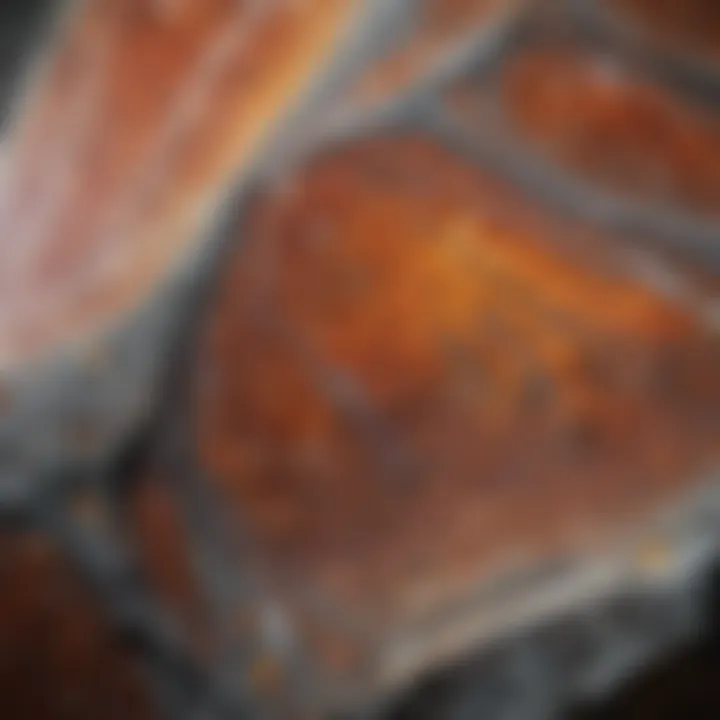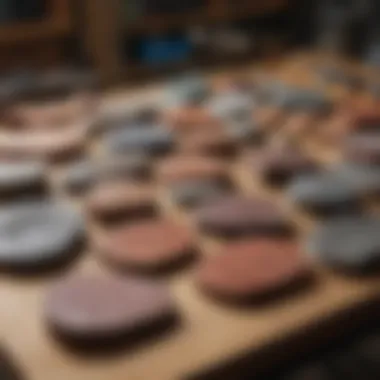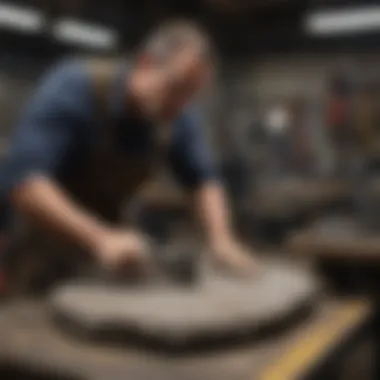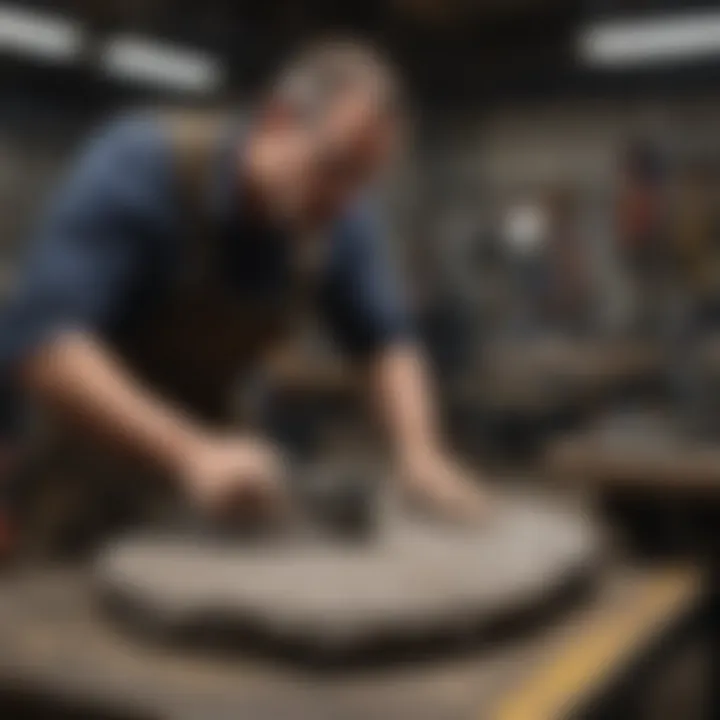Understanding Rock Slab Polishers: A Comprehensive Guide


Intro
Rock slab polishers represent a unique intersection of art and science in the realm of geology. For enthusiasts and collectors, these tools are not mere machines but instruments that can transform rough, unassuming rock slabs into visually stunning specimens. Understanding how these polishers function, their applications, and the proper maintenance required sets the foundation for anyone serious about enhancing their collection or refining their skills.
This guide is designed to provide an in-depth look at the functionalities of rock slab polishers while touching on advanced techniques. Whether you are a beginner or an experienced collector, knowing how to select and operate a polisher effectively will greatly enhance the quality of your finished pieces. Let’s begin with some key highlights.
Featured Collectible of the Month
- Overview
This month, we spotlight the stunning Agate slab. Agate, known for its vibrant colors and intricate banding, is a favorite among collectors. Its diverse appearance makes it an ideal candidate for polishing and showcasing. The process not only brings out the beauty of the stone but also serves as a testament to the effectiveness of using a quality rock slab polisher. - Historical Significance
Agate has been sought after since ancient times. Used by civilizations for jewelry and decorative purposes, its significance extends beyond aesthetics. It is believed to bring protection, growth, and positive energy. As you polish an Agate slab, you engage in a practice rooted in historical appreciation and artistry.
Identification Techniques
Visual Characteristics
Identifying a high-quality slab for polishing involves observing a few key characteristics. Look for:
- Color Vibrancy: True Agate exhibits strong color variations. The more vividly the colors stand out, the more visually captivating the finished product will be.
- Banding Patterns: Unique and intricate banding differs from stone to stone, highlighting the stone's individuality.
- Surface Texture: A smooth surface generally indicates a well-prepared slab, ready to engage in the polishing process.
Resources for Identification
For those embarking on the identification journey, several resources stand out:
- Wikipedia provides a comprehensive overview of Agate features.
- Check out collector forums on Reddit where enthusiasts share their insights and identification techniques.
- Join rock and mineral groups on Facebook, where community members discuss various specimens.
In summary, understanding rock slab polishers is about more than just the technical aspects. It reflects a larger journey of geology appreciation, artistry, and craftsmanship. This guide aims to equip you with valuable knowledge that adds depth to your engagement with these fascinating tools, ultimately enhancing your collecting experience.
Prelude to Rock Slab Polishers
The world of rock slab polishing is an intricate and specialized field that appeals to many enthusiasts. This introduction serves to contextualize the importance of rock slab polishers in both hobbyist and professional settings. These devices not only enhance the aesthetic quality of geological specimens but also preserve their integrity and value. Understanding how these tools work, their historical development, and the purpose they serve will equip collectors and enthusiasts to make informed decisions in their polishing efforts.
Definition and Purpose
A rock slab polisher is a machine designed to smooth and shine rock specimens. These machines typically use abrasive pads and a rotating drum to achieve a polished finish on various types of stone. The primary purpose is to prepare rocks for display or educational purposes. By removing imperfection and enhancing color depth, polishers contribute significantly to preserving the beauty and details of each slab. This functionality is crucial for anyone interested in geology, art, or natural history, as it elevates the presentation of their collections.
Historical Context
The evolution of rock slab polishers is tied closely to advancements in technology and increasing interest in geology. Early forms of polishing tools were simple and labor-intensive, often requiring physical effort to achieve a desired finish. As the demand for polished stones grew, so did innovation in machinery. The introduction of electric polishers in the mid-20th century revolutionized the field, making the process more efficient and accessible to a broader audience. Today, the variety of machines available caters to different needs, from hobbyists choosing manual models to professionals utilizing industrial machines. This historical perspective highlights how both technological progress and human interest have shaped the landscape of rock polishing.
Types of Rock Slab Polishers
Understanding the different types of rock slab polishers is crucial for anyone interested in refining their rock and fossil collection. Each type serves unique functionalities and has its own advantages, thus allowing enthusiasts to select a model that best fits their specific needs. Selecting the correct type can greatly affect the polishing results and the efficiency of the process.
Manual Polishers
Manual polishers are favored for their simplicity and control. These machines require more physical effort but provide a meticulous approach to polishing rock slabs. They often allow users to carefully manage pressure and speed, resulting in a polished finish that highlights the natural beauty of the rock.
The benefits of manual polishers include:
- Affordability: Generally cheaper than electric or industrial variants.
- Portability: Easier to transport for fieldwork or small projects.
- Precision: Hand-operated devices allow for focused polishing in specific areas.
However, they do require more time and effort. Users must be committed to the work, as results may vary based on experience and technique.
Electric Polishers
Electric polishers represent a significant step up in efficiency. They automate much of the polishing process, leading to quicker results compared to manual units. This type is great for consistent finishes and can handle various types of rock materials.
Some notable features of electric polishers are the following:
- Speed Control: Offers adjustable settings allowing operators to choose the appropriate speed based on the hardness of the material.
- Less Physical Strain: Reduces fatigue as the machine does most of the hard work.
- Uniformity of Results: Many electric polishers include polishing pads and instructions designed to yield even finishes.
Despite these benefits, users should consider factors such as the initial investment cost and the machine's power consumption. Choosing the right electric model can ultimately streamline the polishing process.
Industrial Polishers
Industrial polishers are the most powerful and are designed for heavy-duty use. These machines are ideal for large-scale operations, such as workshops or commercial settings, where efficiency and speed are paramount. They are equipped with robust motors and often feature multi-stage polishing systems.
Important aspects of industrial polishers include:
- Durability: Built for extensive use, these machines can endure high workloads without compromising performance.
- Efficiency: Capable of processing multiple slabs simultaneously, significantly reducing time versus manual and electric systems.
- Customization Options: Many industrial units allow for customization regarding drum size and motor specifications to suit specific polishing tasks.
While their performance is unmatched, industrial polishers typically require a higher financial commitment and dedicated space. Evaluating whether the scale of project justifies such an investment is important for potential users.
"Choosing the right type of rock slab polisher can enhance the outcome of your polishing efforts and tailor the experience to your specific requirements."


In summary, knowing the types of rock slab polishers available is fundamental to maximizing your polishing efforts. Be it manual, electric, or industrial, each type provides unique advantages that cater to different needs within the realm of rock and fossil collecting.
Key Components and Features
When considering rock slab polishers, understanding the key components and features is crucial. These elements determine not just the efficiency of the polishing process but also the final quality and safety of the operation. The primary components that typically get attention are the motor specifications, drum types, and safety features. Each of these plays a significant role in optimizing performance and ensuring user safety.
Motor Specifications
The motor is the powerhouse of any rock slab polisher. Its specifications often include both power rating and RPM (revolutions per minute). A high power rating indicates the ability to handle tougher materials or larger slabs. For hobbyists, a motor around 1 to 2 horsepower is generally sufficient. However, for industrial applications, motors above 2 horsepower may be necessary to manage larger slabs and high workload demands.
Moreover, RPM is equally vital. The higher the RPM, the quicker the polishing action. However, there is also a risk of overheating or damaging softer materials at excessive speeds. Therefore, many polishers come with adjustable speed settings. This versatility allows users to adapt their approach based on the unique characteristics of the rock, ensuring that they do not compromise on quality while ensuring efficient operation.
Drum Types
The drum of a rock slab polisher is another key element that affects the polishing outcome. Generally, there are two types of drums: fixed drums and rotating drums. Fixed drums provide a consistent surface for polishing, making them ideal for those who prefer a straightforward process. They typically require more time to achieve the desired polish but offer a more controlled environment.
On the other hand, rotating drums can greatly increase the speed of the polishing process. They often come in different sizes and materials, like rubber or metal, each designed for specific types of polishing tasks. Rubber drums are gentler and are best for softer rocks, while metal drums may be used for more abrasive tasks. Depending on the user’s requirements, choosing the right drum type is essential for optimizing results and protecting the integrity of the rock.
Safety Features
In any equipment design, safety features are paramount. Rock slab polishers are no exception. Common safety features include emergency stop buttons, protective covers, and safety guards to prevent accidental injuries. Such components protect not only the user but also the machine itself.
Additionally, having proper ventilation is also an important safety consideration. During operation, particles can become airborne, posing a respiratory hazard. Some advanced units come equipped with built-in dust collection systems to mitigate this risk. Safety goggles and hearing protection are recommended for all users, regardless of the machine's built-in safety features.
"Understanding the key components of a rock slab polisher can significantly impact both the efficiency and safety of your polishing experience."
By focusing on motor specifications, drum types, and safety features, users can make more informed decisions when selecting a rock slab polisher. The right combination enhances performance while ensuring safety, which is critical for both hobbyists and professionals.
Selecting a Rock Slab Polisher
Selecting a rock slab polisher is a crucial step for enthusiasts and professionals alike. The right polisher not only affects the quality of the finished rock slab but also influences the efficiency of the polishing process. Many factors must be considered to ensure the chosen machine aligns with the user's specific needs and goals.
Identifying Your Needs
Before making a purchase, it‘s essential to analyze what you need from a polisher. Consider the types of rocks you work with and the scale of your polishing projects. A hobbyist may only require a smaller, manual polisher, while a commercial user might opt for a larger, more powerful electric model. Think about:
- The size and type of rock slabs you typically polish.
- Your level of experience in rock polishing.
- How often you plan to use the machine.
- The desired finishing quality.
Assessing these factors can guide your choice toward a polisher that will best serve your purpose without causing frustration or underperformance.
Budget Considerations
The budget plays an important role when selecting a rock slab polisher. Prices can vary significantly based on the model, brand, and features. Setting a reasonable budget helps narrow down choices and ensures you do not overspend. While a higher investment might suggest better quality, it is not always the case. Keep in mind:
- Initial cost versus long-term value.
- Possible need for additional accessories or consumables.
- Warranty and servicing options.
There are polishers available across a wide price range. Evaluate features in relation to your budget, ensuring that you achieve a balance between cost and performance.
Comparing Brands
Brand selection can influence the quality and durability of your polisher. Different manufacturers offer varying features, service support, and user experiences. It is recommended to research well-known brands and read reviews from other users before making a choice. Key factors include:
- Reputation among rock and mineral collectors.
- Availability of replacement parts and accessories.
- Customer service and technical support.
This careful examination of brands can lead to a more informed decision, helping you find a polisher that meets both performance expectations and reliability.
Operating a Rock Slab Polisher
Operating a rock slab polisher effectively is crucial for achieving the desired finish on various stone specimens. This section discusses the importance of the topic and provides essential insights into the techniques and considerations necessary for optimal results.
Setup and Preparation
The initial step in operating a rock slab polisher is preparation. Before plugging in the machine, one must ensure that the workspace is organized and maintained. A clean area minimizes the risk of contamination. Dust, dirt, or foreign objects can scratch or damage the stones being polished.
Begin by arranging all necessary tools, such as polishing pads, water supply, and safety equipment including goggles and gloves. Ensure the polisher itself is located on a stable surface to prevent wobbling during operation.
Next, inspect the stones that will be polished. Clean them to remove any debris. Wet the stones appropriately, as this reduces heat and dust during the polishing process. Proper setup ensures smoother operation and higher quality results.
Polishing Techniques
The effectiveness of polishing largely depends on the techniques employed. There are several stages in the polishing process, each serving a distinct purpose. The initial stage typically involves using coarse pads to remove rough surfaces. Once the surface is relatively smooth, it is advisable to transition to medium-fine pads.
- Starting with Coarse Pads: Begin using 60 to 120 grit pads. These pads help in removing deep scratches and imperfections from the stone.
- Transitioning to Medium Pads: Next, use 220 to 400 grit pads. This stage refines the surface further, creating a better foundation for final polishing.
- Finishing Touches: For the final polishing, use pads ranging from 800 grit to 3000 grit based on the desired finish. This step brings out the natural luster and beauty of the stone.
During polishing, always keep the stone and pads lubricated with water. This prevents overheating and prolongs the life of the pads. Remember that patience is key; rushing through the stages may lead to subpar outcomes.


Troubleshooting Common Issues
Despite careful setup and technique application, issues may arise during the polishing process. Knowing how to respond to these problems is vital for minimizing frustrations.
Common issues include:
- Scratches Left Behind: If scratches remain after polishing, it might indicate that you did not use a coarse enough pad in the initial stages. Ensure to backtrack and address this issue.
- Uneven Shine: This can result from applying uneven pressure. When polishing, maintain an even hand to avoid uneven surfaces. Also, inspect the stone for any inherent variations.
- Excess Dust: Excessive dust can be a sign of using overly coarse pads for too long. Monitor the materials and switch to finer pads as necessary.
"Proper setup and technique are the foundations of effective rock polishing. Addressing issues promptly can save both time and materials."
Additionally, staying organized throughout the process can help prevent many common issues. By following the guidelines outlined above, collectors can enhance their experience and results with rock slab polishing.
Maintenance and Care
Maintaining a rock slab polisher is essential for ensuring its longevity and optimal performance. Proper care not only enhances the efficiency of the machine but also leads to better polishing results. Neglecting maintenance can result in subpar finishes and may even damage both the polisher and the slabs being worked on. Therefore, it is critical to follow a structured maintenance routine to ensure that the equipment remains in good working condition.
Routine Cleaning
Routine cleaning of the rock slab polisher is vital. After each use, it is important to remove any dust, dirt, or polishing residue that may accumulate. A clean machine works better and reduces wear on components. Here are some steps to consider:
- Wipe Down Surfaces: Use a damp cloth to wipe down the exterior. This helps remove any particles that can scratch the surface.
- Clean the Drum: Depending on the material polished, residue may accumulate on the drum. Using a soft brush or cloth can help keep it clean.
- Inspect Water Reservoirs: If the polisher uses water, make sure to check and clean the water reservoirs. This prevents the growth of mold or bacteria.
Establish a cleaning routine wherein after every few hours of usage, a thorough cleaning is done to keep the machine at its best.
Parts Replacement
Regular replacement of worn-out parts is crucial to maintaining the performance of a rock slab polisher. Some components may wear down faster than others due to continuous use. Keeping an eye on these parts can save time and money in the long run. Here are parts that typically require replacement:
- Polishing Pads or Discs: These get worn down with use and must be replaced once the polishing starts to diminish.
- Belts: If the polisher uses belts, check for fraying or degradation.
- Motor Brushes: Over time, motor brushes can wear down, affecting efficiency. Regular checks will help in timely replacements.
Ensure to keep a log of when parts were last replaced. This helps in knowing when to order new components.
Storage Recommendations
Proper storage of a rock slab polisher is equally important as maintenance. How you store the device can impact its lifespan significantly. Follow these guidelines for best practices:
- Dry Environment: Always store the polisher in a dry setting to avoid rust or corrosion.
- Cover the Machine: Using a dust cover will protect it from debris and moisture during storage.
- Keep Away from Direct Sunlight: Excessive sunlight can degrade plastic components over time.
Following a regimen of regular cleaning, timely parts replacement, and thoughtful storage ensures that your rock slab polisher will continue to perform effectively and efficiently over time.
Applications of Rock Slab Polishers
Understanding the applications of rock slab polishers provides valuable insight into their role in various contexts. Their versatility makes them indispensable tools for multiple users ranging from hobbyists to professionals. Each application has its own unique benefits and considerations, reflecting the diverse needs of the rock and fossil community.
Hobbyist Uses
Hobbyists often rely on rock slab polishers to refine and beautify their geological specimens. This usage stems from a desire to enhance the visual appeal of rocks, which can be intricately layered or colored. By using a polisher, enthusiasts can achieve a smooth and glossy finish that enhances the natural beauty of the rock.
The polishers enable collectors to work with various materials, including agates, jaspers, and other semi-precious stones. Through polishing, hobbyists can bring out vibrant colors and intricate patterns that are sometimes hidden beneath rough surfaces. This not only augments aesthetic value but also increases the potential for resale.
Key benefits for hobbyists include:
- Improved aesthetic appeal of specimens
- Increased value of polished stones
- Enjoyment of the polishing process
Commercial Applications
In commercial settings, rock slab polishers play a critical role in the production of polished stone products. Businesses that deal with raw stone, such as suppliers of countertops or tiles, depend heavily on these machines to provide a refined finish. A polished surface not only improves the appearance of the stone but also enhances its durability.
The precision and efficiency of electric polishers allow manufacturers to create consistent finishes across large volumes, which is essential in maintaining quality standards. Moreover, such polishers can be set up for specific types of stone, enabling businesses to cater to different market needs effectively.
Considerations for commercial use often revolve around:
- Capacity: Suitable for high-volume operations
- Durability: Machines must withstand constant use
- Cost-effectiveness: Profit margins depend on efficient processes
Artistic Ventures
Artists and creators also benefit from the capabilities of rock slab polishers. For those who incorporate stone in their work, the ability to polish can transform a rough piece into a stunning art item. Many artists appreciate the tactile feedback of working with polished stones and gravitate towards the aesthetic qualities that polishing can bring out in their pieces.
Polishing can also serve as a means of experimentation for artistic designs. Artists can combine polished stones with other media, leading to unique creations that blend natural beauty with artistic expression.
Factors to consider for artistic applications include:
- Material compatibility: Not all stones are suited for the same techniques
- Finishing techniques: Different tools can create diverse outcomes
- Inspiration sources: Natural patterns in stones can inspire unique designs


"The capabilities of rock slab polishers stretch beyond mere function; they are tools for transformation."
In summary, rock slab polishers serve various applications that cater to hobbyists, commercial enterprises, and artists alike. Each group finds specific benefits and considerations that enhance their craft, emphasizing the importance of these tools across different segments of the rock and fossil community.
Environmental Considerations
Understanding the role of environmental considerations in rock slab polishing is crucial for enthusiasts and collectors alike. The practices and techniques used in this field can have significant ecological impacts. It is important to balance the pursuit of perfect rock surfaces with responsible environmental stewardship. This section will cover waste management and sustainable practices as essential components of maintaining this balance.
Waste Management
Effective waste management is a key aspect of minimizing the environmental footprint associated with rock slab polishing. Throughout the polishing process, waste can accumulate in various forms, including dust, slurry, and used polishing materials.
To address this, collectors and enthusiasts should follow specific guidelines:
- Hazardous Waste Disposal: Materials that contain chemicals must be disposed of in accordance with local regulations. This may involve contacting hazardous waste facilities or recycling centers that can handle such materials appropriately.
- Water Management: Slurry produced during polishing can pollute local water sources. It is advisable to use containment systems that filter and treat this water before it is released.
- Recycling Materials: Used pads and grits can often be recycled. Engaging in dialogue with suppliers or local groups can provide options for recycling.
Implementing these waste management strategies not only helps protect the environment but also enhances the reputation of the rock polishing community as a whole.
Sustainable Practices
Incorporating sustainable practices into rock slab polishing can greatly reduce the overall impact on the environment while helping enthusiasts and collectors maintain their craft. These practices focus on long-term ecological health and efficient resource use. Here are some key strategies:
- Energy Efficiency: Selecting electric polishers that feature energy-saving technology can reduce electricity consumption. This choice reflects a commitment to sustainability without sacrificing performance.
- Eco-Friendly Products: Some polishing compounds are formulated to be less harmful to the environment. Opting for these products helps minimize chemical exposure for both users and ecosystems.
- Sourcing Locally: By obtaining materials and resources locally, travel emissions can be reduced, thereby lessening the overall carbon footprint of the polishing process.
"Sustainable practices not only protect the environment but also ensure the longevity of the rock polishing community."
Ultimately, integrating these sustainable practices into the polishing routine can foster a greater appreciation for both rocks and the environment. Collectors and enthusiasts are encouraged to be mindful and proactive regarding their environmental impact.
Future Trends in Rock Polishing Technology
The field of rock polishing technology is evolving rapidly. Understanding these trends is crucial for enthusiasts and collectors who seek to optimize their polishing methods. Future advancements bring improvements not just in efficiency but also in achieving better results. As technology progresses, new methods and materials will likely enhance the art of rock polishing.
Automation and Robotics
Automation is becoming increasingly relevant in rock polishing. Automated systems allow for consistent results while reducing the physical effort required from users. This shift also minimizes errors associated with manual processes. Robotics can handle repetitive tasks, enabling users to focus on creative aspects of polishing.
The integration of sensors and artificial intelligence can offer personalized polishing settings based on the type of rock. Users can upload specifications, and machines will adjust parameters automatically. This takes much guesswork out of the process and improves overall efficiency.
Innovative Materials
The development of innovative materials is another significant trend. New composite materials for pads and abrasives are emerging, designed to provide finer finishes while being durable. Examples include diamond-infused pads that last longer and perform better on hard rocks. These advancements lead to quicker polishing without compromising quality.
Furthermore, environmentally friendly materials are gaining traction. Many collectors now prefer products that reduce harmful waste and limit energy use. Utilizing sustainable materials aligns with broader environmental goals, making it a compelling consideration in product development.
"The future is not just about efficiency; it’s also about sustainability and quality in polishing techniques."
In summary, automation and innovative materials represent key future trends in rock polishing technology. These developments are setting the stage for more effective, sustainable, and user-friendly polishing processes.
Culmination
In the realm of rock polishing, understanding the role of a rock slab polisher is vital for both enthusiasts and professionals alike. The conclusion of this guide serves to synthesize the main elements discussed throughout the article, emphasizing the practical wisdom one can take away regarding the use and care of rock slab polishers.
Summary of Key Points
Throughout this guide, we examined various facets of rock slab polishers. Key takeaways include:
- Types of Polishers: Different machines cater to distinct needs, such as manual, electric, and industrial models. each with unique functionalities.
- Key Features: Important components like motor specifications and drum types influence polishing efficiency. Safety features cannot be overlooked for operator security.
- Operating Techniques: Proper setup, polishing methods, and troubleshooting techniques are essential for successful results.
- Maintenance: Regular cleaning, parts replacement, and proper storage extend the lifespan of your polisher.
- Environmental Considerations: Addressing waste management and adopting sustainable practices is increasingly important in modern polishing processes.
- Future Trends: Innovations such as automation and sustainable materials promise to reshape the landscape of rock polishing technology.
This concise understanding helps users to navigate their choices and practices effectively.
Final Recommendations
- Identify Your Needs: Decipher whether your primary interest lies in hobbyist work or professional applications. This influences the type of polisher you select and its capabilities.
- Budget Wisely: While higher-end models may offer advanced features, it is crucial to balance quality with your budget constraints. Never compromise safety for cost.
- Keep Up with Trends: Stay informed about emerging technologies and techniques in the industry. Early adoption of new practices can enhance polishing results and environmental safety.
By following these considerations and leveraging insights presented in this comprehensive guide, users can refine their skills and enhance their enjoyment of rock polishing.
Importance of Quality References
Using trustworthy sources is essential for anyone in the rock polishing community. These resources not only offer factual information about the devices but also include insights into best practices. High-quality references can help users navigate through the complexities of the polishing process and avoid common pitfalls. For instance, manuals from manufacturers like Lortone or Covington Engineering can provide helpful instructions specific to their models, ensuring proper usage and maintenance.
Types of References
- Manufacturers’ Manuals: These documents often contain specific details about each model, such as setup guidance and troubleshooting steps.
- Online Articles and Guides: Websites like en.wikipedia.org and britannica.com can offer more general insights into the history and technology behind rock polishers.
- Community Forums: Platforms like reddit.com allow users to share personal experiences, which can be invaluable for practical tips. Engaging with such communities can also introduce new techniques as well as suggestions for products that other collectors have found beneficial.
Benefits of Utilizing References
- Improved Techniques: Quality references can introduce enhanced polishing methods, expanding your skill set.
- Understanding Equipment: Knowledge about the individual components of a polisher can lead to better decision-making when selecting or maintaining a machine.
- In-Depth Knowledge: Comprehensive information can provide insights into the historical context and future trends in rock polishing technology.
Reference materials become critical not just for the process of polishing itself, but also for understanding the broader implications of rock and fossil care. Properly utilizing references can showcase the commitment one has to mastering this art, ultimately enhancing the value of one's collection.
"Knowledge is less about what you do with it and more about what you learn from it."



